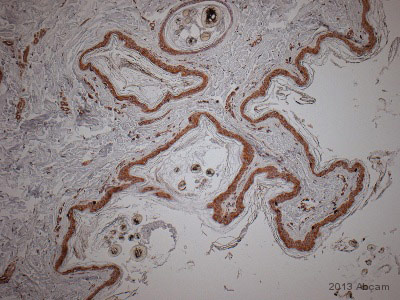Anti-NQO1 antibody [A180]
| Name | Anti-NQO1 antibody [A180] |
|---|---|
| Supplier | Abcam |
| Catalog | ab28947 |
| Prices | $403.00 |
| Sizes | 100 µg |
| Host | Mouse |
| Clonality | Monoclonal |
| Isotype | IgG1 |
| Clone | A180 |
| Applications | ELISA IP FC WB ICC/IF ICC/IF ELISA IHC-P |
| Species Reactivities | Mouse, Rat, Dog, Human, Monkey |
| Antigen | Recombinant full length protein of Human NQO1 |
| Description | Mouse Monoclonal |
| Gene | NQO1 |
| Conjugate | Unconjugated |
| Supplier Page | Shop |
Product images
Product References
Activation of Nrf2 in keratinocytes causes chloracne (MADISH)-like skin disease - Activation of Nrf2 in keratinocytes causes chloracne (MADISH)-like skin disease
Schafer M, Willrodt AH, Kurinna S, Link AS, Farwanah H, Geusau A, Gruber F, Sorg O, Huebner AJ, Roop DR, Sandhoff K, Saurat JH, Tschachler E, Schneider MR, Langbein L, Bloch W, Beer HD, Werner S. EMBO Mol Med. 2014 Apr;6(4):442-57.
Sodium hydrosulfide inhibits the differentiation of osteoclast progenitor cells - Sodium hydrosulfide inhibits the differentiation of osteoclast progenitor cells
Gambari L, Lisignoli G, Cattini L, Manferdini C, Facchini A, Grassi F. Pharmacol Res. 2014 Sep;87:99-112.
Seaweed extracts and unsaturated fatty acid constituents from the green alga Ulva - Seaweed extracts and unsaturated fatty acid constituents from the green alga Ulva
Wang R, Paul VJ, Luesch H. Free Radic Biol Med. 2013 Apr;57:141-53. doi:
Oxidative stress and Nrf2 signaling in McArdle disease. - Oxidative stress and Nrf2 signaling in McArdle disease.
Kitaoka Y, Ogborn DI, Nilsson MI, Mocellin NJ, MacNeil LG, Tarnopolsky MA. Mol Genet Metab. 2013 Nov;110(3):297-302.
Association of p62/SQSTM1 excess and oral carcinogenesis. - Association of p62/SQSTM1 excess and oral carcinogenesis.
Inui T, Chano T, Takikita-Suzuki M, Nishikawa M, Yamamoto G, Okabe H. PLoS One. 2013 Sep 24;8(9):e74398.
Nrf2-dependent and Nrf2-independent induction of phase 2 detoxifying and - Nrf2-dependent and Nrf2-independent induction of phase 2 detoxifying and
Piao MS, Park JJ, Choi JY, Lee DH, Yun SJ, Lee JB, Lee SC. Arch Dermatol Res. 2012 Jul;304(5):387-95.
Global gene expression profiling of endothelium exposed to heme reveals an - Global gene expression profiling of endothelium exposed to heme reveals an
Ghosh S, Tan F, Yu T, Li Y, Adisa O, Mosunjac M, Ofori-Acquah SF. PLoS One. 2011 Mar 31;6(3):e18399.
Hepatitis C virus proteins activate NRF2/ARE pathway by distinct ROS-dependent - Hepatitis C virus proteins activate NRF2/ARE pathway by distinct ROS-dependent
Ivanov AV, Smirnova OA, Ivanova ON, Masalova OV, Kochetkov SN, Isaguliants MG. PLoS One. 2011;6(9):e24957.
Pyrimidine biosynthesis links mitochondrial respiration to the p53 pathway. - Pyrimidine biosynthesis links mitochondrial respiration to the p53 pathway.
Khutornenko AA, Roudko VV, Chernyak BV, Vartapetian AB, Chumakov PM, Evstafieva AG. Proc Natl Acad Sci U S A. 2010 Jul 20;107(29):12828-33. doi:
.
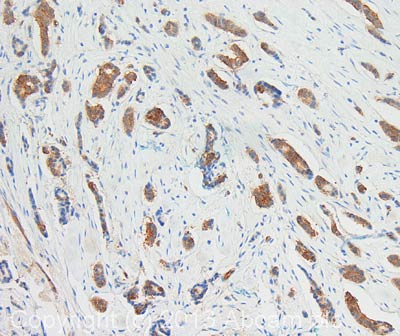
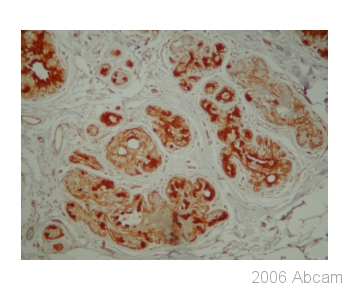
![Lane 1 : MarkerLane 2 : Anti-NQO1 antibody [A180] (ab28947) at 1 µg/mlLane 1 : As aboveLane 2 : Kidney (Human) Tissue Lysate (ab7920) at 20 µgSecondaryLane 2 : IRDye 680 Conjugated Goat Anti-Mouse IgG (H+L) at 1/10000 dilution](http://www.bioprodhub.com/system/product_images/ab_products/2/sub_4/1778_ab28947_2.jpg)
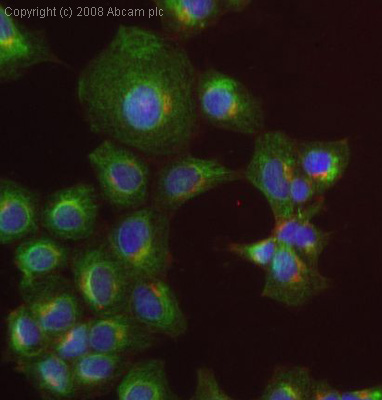
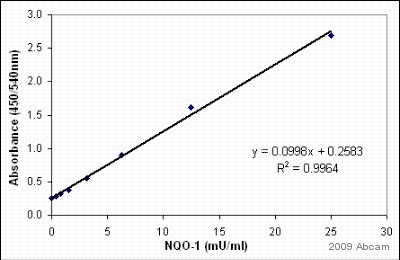
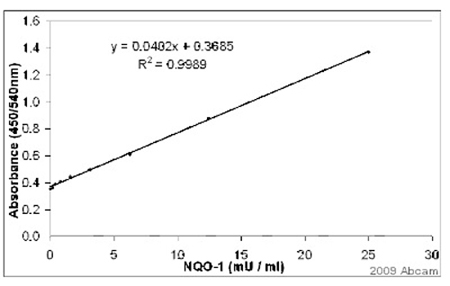
![Overlay histogram showing HeLa cells stained with ab28947 (red line). The cells were fixed with 80% methanol (5 min) and then permeabilized with 0.1% PBS-Tween for 20 min. The cells were then incubated in 1x PBS / 10% normal goat serum / 0.3M glycine to block non-specific protein-protein interactions followed by the antibody (ab28947, 1µg/1x106 cells) for 30 min at 22ºC. The secondary antibody used was goat anti-mouse DyLight® 488 (IgG H+L) (ab96879) at 1/500 dilution for 30 min at 22ºC. Isotype control antibody (black line) was mouse IgG1 [ICIGG1] (ab91353, 2µg/1x106 cells) used under the same conditions. Acquisition of >5,000 events was performed. This antibody gave a positive signal in HeLa cells fixed with 4% paraformaldehyde (10 min)/permeabilized with 0.1% PBS-Tween for 20 min used under the same conditions.](http://www.bioprodhub.com/system/product_images/ab_products/2/sub_4/1782_NQO1-Primary-antibodies-ab28947-17.jpg)
